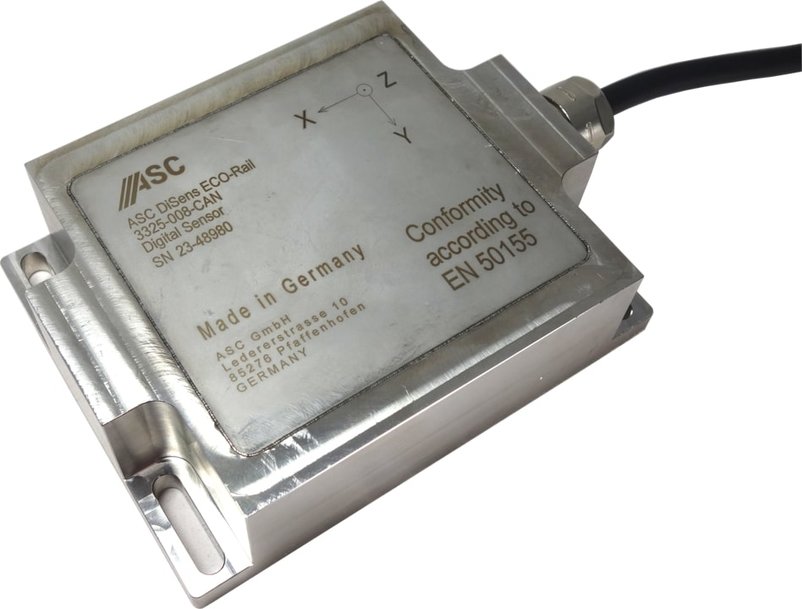ECO Rail: Railway Monitoring Made Simple & Smart
Railway Monitoring Made Simple & Smart.

Sensors used in the monitoring of railway stock and infrastructure management are typically developed to meet the toughest technical criteria while resisting the hardest shocks, vibrations, a range of other forces and environmental conditions.
To make certification testing and smooth railway operations a lot easier for clients and bring down their costs, too, the triaxial ASC DiSens® ECO-Rail digital accelerometer recently passed the rigorous tests according to EN 50155 (IEC 60571) and was approved to this important international standard.
Enhancing Railway Capacity, Safety and Productivity
The digital ASC DiSens ECO-Rail-3325 with CAN interface has been specially developed to detect, monitor and help prevent subtle yet damaging vibrations impacting railroad construction and maintenance machines over time. It smoothly integrates with rail infrastructure operators’ hard and software standards, ensures the comprehensive tracking of all parameters determining a machine’s ‘health’ and helps reduce the cost of maintenance, repair, breakdown and service disruptions.
The sensor innovation premiered at the recent Railway Forum 2023 in Berlin, Germany.
Renate Bay, Managing Director at ASC Sensors, said:
“Since our digital accelerometer passed all requirements under EN 50155, it is now available to rail network operators who wish to further strengthen their system’s capacity, safety and productivity.”
To install electronic equipment on a train or other rolling stock, it must comply with EN 50155 (IEC 60571) standards for environmental, shock, vibration, power supply, EMC, power surge, ESD and transient factors that could occur when in use.
Benefits for Rail and Infrastructure Operators
Galvanic isolated sensors offer enhanced protection to railway electronics against harmful voltage transients and electrical noise, commonly arising from traction systems, motors and other onboard equipment. These sensors effectively break ground loops, eliminating unwanted current flows and ensuring accurate measurements. Additionally, they seamlessly interface between varying voltage levels within a train’s subsystems, promoting efficient communication without direct electrical connections. This ensures optimal performance and prolongs onboard electronics’ lifespan, leading to reduced maintenance and costs.
Bay states:
“In addition, for our clients EN 50155 conformity of our sensors means a significant simplification and cost reduction of their overall railway operation and certification processes.”
Sensor Control Made Simple
In addition, the ASC DiSens ECO-Rail comes with integrated ‘Micro Control’ firmware.
Bay explains:
“This empowers customers to configure their own sensor equipment and make direct adjustments.
“Our firmware facilitates the interaction between sensor element, CAN interface and the user – for simple control and smooth operation.”
Flexible parameters including measurement ranges, frequencies or various filter settings are now under the direct control of the rail operator.
Integration in the train’s digital network via the digital CAN interface and compatibility with the 24 volt power system are additional features that make this latest digital accelerometer from the ASC range particularly suitable for rail applications. It had been developed for a project in partnership with the Digital Railway Solutions Alliance.
Solutions for a ‘Digital Railway Future’
In May, 2022, at the International Railway Forum (IAF) in Münster, Germany, 15 leading European rail infrastructure technology companies launched a new collaboration: the Digital Railway Solutions (DRS) Alliance. Through an open innovation platform, the manufacturers and service providers of diverse high-tech solutions collaborate to improve the safety, efficiency and capacity of the world’s railway networks.
Bay says:
“We are proud to be part of the DRS Alliance. With our analog, digital and smart sensor products, ASC is able to make unique contributions to the success of this group and, importantly, to that of our customers benefitting from the combined expertise and integrated solutions across the breadth of this unique alliance.”
From Digital to Smart
However, despite its compelling features the digital ASC ECO-Rail sensor is not yet the end of rail sensor innovation. As the ASC AiSys ECO-Rail smart sensor takes it another step further: “Customized to client requirements, our smart sensors are able to ‘predict’ future maintenance needs to save yet more time and budget,” Bay clarifies. They do this by combining the captured real-time data with historic and environmental data, to produce instant repair alerts or timely recommendations for the maintenance or replacement of weakening components before something breaks down.
The smart ASC AiSys ECO-Rail sensor, too, adheres to EN 50155 standards. With that, it is as easily embedded in rolling stock as its digital relative. For this smart sensor range, ASC has further optimized its firmware to support a wide range of applications and market specifics. Sensor parameters can be set to align with individual client preferences and needs. Algorithms for FFT and the computation of velocity and displacement can be implemented directly at the sensor; which means that data evaluation and analysis happens in the sensor, which then ‘communicates’ the resulting guidance to the operator to act upon.
Sustainable Rail Mobility
Communication between the sensor system and its user is bi-directional. It is facilitated through a standardized technical interface.
Bay summarizes:
“Our ASC AiSys ECO-Rail smart sensors combine ‘intelligent’ data interpretation and communication.
“With this end-to-end ecosystem of rail monitoring, external data integration, analysis and communication – all in real-time – our smart sensors provide the basis for the development of digital twins to achieve further gains in passenger safety, network capacity and a sustainable future of railway mobility.”
www.asc-sensors.de

